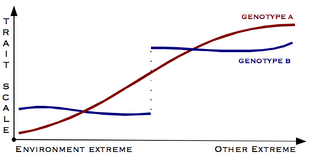
Norms of reaction for two genotypes. Genotype B shows a strongly bimodal distribution indicating differentiation into distinct phenotypes. Each phenotype is buffered against environmental variation - it is canalised.
The ability of an organism with a given genotype to change its phenotype in response to changes in the environment is called phenotypic plasticity. Such plasticity in some cases expresses as several highly morphologically distinct results; in other cases, a continuous norm of reaction describes the functional interrelationship of a range of environments to a range of phenotypes.
Organisms of fixed genotype may differ in the amount of phenotypic plasticity they display when exposed to the same environmental change. Hence phenotypic plasticity can evolve and be adaptive if fitness is increased by changing phenotype. Immobile organisms such as plants have well developed phenotypic plasicity giving a clue to the adaptive significance of phenotypic plasticity.
Assessment |
Biopsychology |
Comparative |
Cognitive |
Developmental |
Language |
Individual differences |
Personality |
Philosophy |
Social |
Methods |
Statistics |
Clinical |
Educational |
Industrial |
Professional items |
World psychology |
Biological: Behavioural genetics · Evolutionary psychology · Neuroanatomy · Neurochemistry · Neuroendocrinology · Neuroscience · Psychoneuroimmunology · Physiological Psychology · Psychopharmacology (Index, Outline)
A highly illustrative example of phenotypic plasticity is found in the social insects, colonies of which depend on the division of their members into distinct castes, such as workers and guards. Individuals in separate castes differ dramatically from one another, both physically and behaviorally. However, the differences are not genetic; they arise during development and depend on the manner of treatment of the eggs by the queen and the workers, who manipulate such factors as embryonic diet and incubation temperature. The genome of each individual contains all the instructions needed to develop into any one of several 'morphs', but only the genes that form part of one developmental program are activated.
In epidemiology, a popular theory is that rising incidences of coronary heart disease and Type II diabetes in human populations undergoing industrialization is due to a mismatch between a metabolic phenotype determined in development and the nutritional environment an individual is subsequently exposed to. This is known as the 'Thrifty phenotype' hypothesis (see Evolutionary psychology).
See also[]
The development of phenotype
|
|---|
| Key concepts: Genotype-phenotype distinction | Norms of reaction | Gene-environment interaction | Heritability | Quantitative genetics |
| Genetic architecture: Dominance relationship | Epistasis | Polygenic inheritance | Pleiotropy | Plasticity | Canalisation | Fitness landscape |
| Non-genetic influences: Epigenetic inheritance | Epigenetics | Maternal effect | dual inheritance theory |
| Developmental architecture: Segmentation | Modularity |
| Evolution of genetic systems: Evolvability | Mutational robustness | Evolution of sex |
| Influential figures: C. H. Waddington | Richard Lewontin |
| Debates: Nature versus nurture |
| List of evolutionary biology topics |
es:Plasticidad fenotípica
| This page uses Creative Commons Licensed content from Wikipedia (view authors). |